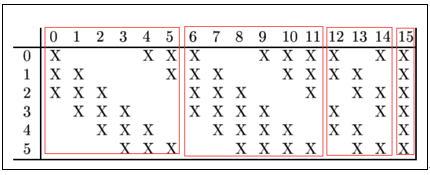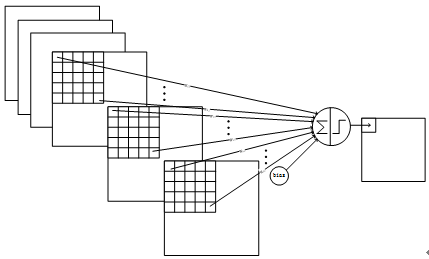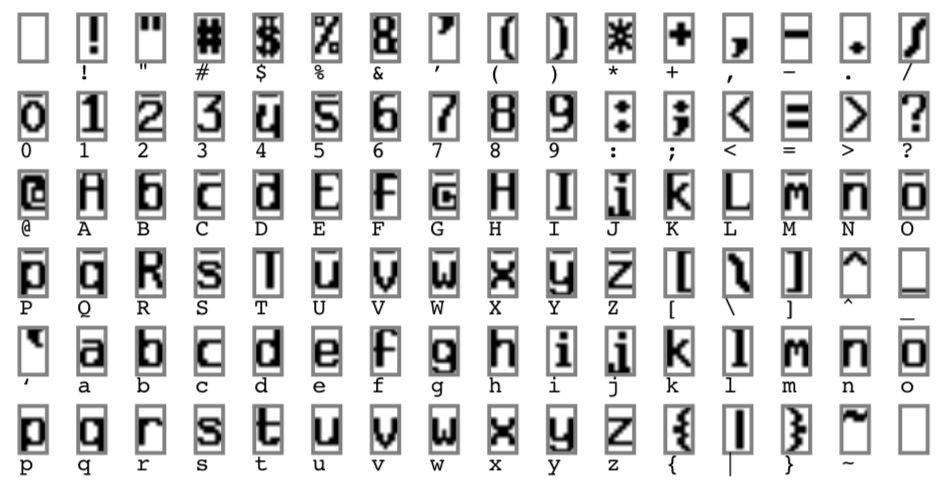计算机视觉系列1 LeNet-5网络的思路和简单实现
本文链接:https://blog.csdn.net/weixin_44633882/article/details/86716096
1.LeNet网络简介
LeNet-5是Yann LeCun提出的,对MNIST数据集的分识别准确度能够达到99.2%

| 层名 | 输出 |
|---|---|
| 输入层INPUT | 32×32 |
| 卷积层C1 | 28×28×6 |
| 下采样层S2 | 14×14×6 |
| 卷积层C3 | 10×10×16 |
| 下采样层S4 | 5×5×16 |
| 全连接层C5 | 120 |
| 全连接层F6 | 84 |
| 输出层OUTPUT | 10 |
2.LeNet每层网络的计算
(1) INPUT层
- 输出:32×32×1
(2) C1层(卷积层)
- 输入:32×32×1 输出:28×28×6 (32-5+1)
- 卷积核:大小:5×5×6
- 分析:
神经元数量:28×28×6
可训练参数:(5×5+1)× 6 = 156 (卷积核中feature个数+bias)
连接数:(5×5+1)×6×28×28 = 122304(每个卷积核都有一个bias,每次卷积运算的结果都会加上bias)
虽然由122304个连接,但只需要学习156个参数。(权值共享)
(3) S2层(下采样层)非池化层
- 输入:28×28×6 输出:14×14×6
- 感受野:2×2 (将4个数相加,乘上一个可训练的系数,加上bias,输入sigmoid)
- 分析:
神经元数量:14×14×6
可训练参数:12 (权值+bias)×6
连接数:(2×2 + 1)×6×14×14 = 5880 (感受野中的四个元素加上bias,很好奇为什么没有加上乘的权重)
(4) C3层(卷积层)
- 输入:14×14×6 输出:10×10×6 (14-5+1)
- 卷积核:大小:5×5×16
- 分析:
神经元数量:10×10×16
可训练参数:(5×5×6+1)×166×(3×5×5+1)+6×(4×5×5+1)+3×(4×5×5+1)+1×(6×5×5+1) = 1516
连接数:(5×5+1)×10×10×1610×10×1516 = 151600(连接数计算应该反向计算,1516是一个feature所需要的连接数) - 说明:
C3中每个feature map不都是与S2中的所有feature map相连接的
C3这层,将6个14×14的feature map转换为 16个10×10的feature map
这边使用特殊组合来完成

列表示C3中的feature map序列号
行表示S2中的feature map序列号 - 第一个红框:
C3中的前6个feature map每个都是与3个S2中的feature map相连接
可训练参数:(3×5×5+1)×6
这张图就很容易理解了

- 第二个红框:
C3中的6-11的feature map每个都是与4个S2中的feature map相连接
可训练参数:(4×5×5+1)×6 - 第三个红框:
C3中的12-14的feature map每个都是与3个S2中的feature map相连接(不连续的子集)
可训练参数:(4×5×5+1)×3 - 第四个红框:
C3中的15 feature map与S2中所有的feature map相连接
可训练参数:(6×5×5+1)×1
为什么要采用上面的连接方案,而不是直接与所有的feature map相连接?
1.不完全的链接可以减少参数和连接数。
2.每个特征图都是从原来的特征中提取更抽象的特征,采用这样不对称的链接,可以使提取出不同的更高级的特征。
(5) S4层(下采样层)
- 输入:10×10×6 输出:5×5×16
- 感受野:2×2
- 分析:
过程和S2的步骤相似
神经元数量:5×5×16
可训练参数:32 (2×6)2表示乘的权重加上bias
连接数: (2×2+1)×5×5×16 = 2000
(6) C5层(卷积层)用卷积层实现全连接层的功能
- 输入:5×5×16 输出:1×1×120
- 卷积核:大小:5×5×120
- 分析:
可训练参数:(5×5×16 + 1)×120 =48120(每个卷积核对应一个bias)
(7) F6层(全连接层)
- 输入:1×1×120 输出:1×1×84
- 计算:向量点积,加上bias,输入tanh激活函数
tanh函数: f ( a ) = A t a n h ( S a ) f(a)=Atanh(Sa) f(a)=Atanh(Sa)
A为振幅,S可认为斜率,论文中,A=1.7159 - 分析:
可训练参数:(120+1)×84 = 10164
(8) 输出层
输出层由10个欧几里得径向基函数(RBF)构成,每个RBF对应0-9中的一个类别。
RBF函数的输出:
y
i
=
∑
j
(
x
j
−
w
i
j
)
2
y_i=\sum_{j}{(x_j-w_{ij})^2}
yi=j∑(xj−wij)2
X
→
\overrightarrow{X}
X是F6层输出的向量,
x
i
∈
X
→
=
{
x
1
,
.
.
.
,
x
i
,
.
.
,
x
84
}
x_i∈\overrightarrow{X} = \{x_1,...,x_i,..,x_{84}\}
xi∈X={x1,...,xi,..,x84}
对于一个数字i,RBF保留一个常向量,
w
i
j
∈
w
i
→
=
w
i
1
,
.
.
.
,
w
i
j
,
.
.
.
,
w
i
84
w_{ij}∈\overrightarrow{w_i} = {w_{i1},...,w_{ij},...,w_{i84}}
wij∈wi=wi1,...,wij,...,wi84
RBF函数的输出是输入
X
→
\overrightarrow{X}
X和
w
i
→
\overrightarrow{w_i}
wi的欧几里得距离。
RBF核的向量
w
i
→
\overrightarrow{w_i}
wi中的元素是+1或-1。这些是人为设置的,这样可以在7*14的位图上将字符表示出来。

3. LeNet简单的代码复现
代码参考《TensorFlow实战Google深度学习框架》
代码结构
- dataset
- mnist_data
- …
- mnist_data
- LeNet
- mnist_inference,py
- mnist_test.py
- mnist_train.py
- model
- cheakpoint
- …
(1)模型定义(mnist_inference.py)
import tensorflow as tf
INPUT_NODE = 784
OUT_NODE = 10
IMAGE_SIZE = 28
NUM_CHANNELS = 1
NUM_LABELS = 10
# Layer1
CONV1_DEEP = 32
CONV1_SIZE = 5
# Layer2
CONV2_DEEP = 64
CONV2_SIZE = 5
# 全连接层
FC_SIZE = 512
def inference(input_tensor, train, regularizer):
# input_tensor: [batch, height, width, channels]
with tf.variable_scope('l1-conv1'):
# 输入:28*28*1
# 输出:28*28*32
# 卷积核(5,5,1,32) padding:same
conv1_weights = tf.get_variable(
"weight", [CONV1_SIZE, CONV1_SIZE, NUM_CHANNELS, CONV1_DEEP],
initializer=tf.truncated_normal_initializer(stddev=0.1)
)
conv1_biases = tf.get_variable("bias", [CONV1_DEEP], initializer=tf.constant_initializer(0.0))
conv1 = tf.nn.conv2d(input_tensor, conv1_weights, strides=[1, 1, 1, 1], padding='SAME')
relu1 = tf.nn.relu(tf.nn.bias_add(conv1, conv1_biases))
with tf.name_scope("l2-pool1"):
# 输入:28*28*32
# 输出:14*14*32
pool1 = tf.nn.max_pool(relu1, ksize=[1, 2, 2, 1], strides=[1, 2, 2, 1], padding="SAME")
with tf.variable_scope("l3-conv2"):
# 输入:14*14*32
# 输出:14*14*64
# 卷积核(5,5,32,64)
conv2_weights = tf.get_variable(
"weight", [CONV2_SIZE, CONV2_SIZE, CONV1_DEEP, CONV2_DEEP],
initializer=tf.truncated_normal_initializer(stddev=0.1)
)
conv2_biases = tf.get_variable("bias", [CONV2_DEEP], initializer=tf.constant_initializer(0.0))
conv2 = tf.nn.conv2d(pool1, conv2_weights, strides=[1, 1, 1, 1], padding='SAME')
relu2 = tf.nn.relu(tf.nn.bias_add(conv2, conv2_biases))
with tf.name_scope("l4-pool2"):
# 输入:14*14*64
# 输出:7*7*64
pool2 = tf.nn.max_pool(relu2, ksize=[1, 2, 2, 1], strides=[1, 2, 2, 1], padding='SAME')
# 矩阵转换: 将pool2(7*7*64)转换为一维向量,作为后面的输入
# 输入: (batch_size) 14*14*64
# 输出: (batch_size, 7*7*64)
pool_shape = pool2.get_shape().as_list()
nodes = pool_shape[1] * pool_shape[2] * pool_shape[3]
reshaped = tf.reshape(pool2, [pool_shape[0], nodes])
with tf.variable_scope('l5-fc1'):
# 输入: 7*7*64
fc1_weights = tf.get_variable("weight", [nodes, FC_SIZE],
initializer=tf.truncated_normal_initializer(stddev=0.1))
if regularizer != None:
# 只有全连接层的权重需要加入正则化
tf.add_to_collection('loss', regularizer(fc1_weights))
fc1_biases = tf.get_variable('bias', [FC_SIZE], initializer=tf.constant_initializer(0.1))
fc1 = tf.nn.relu(tf.matmul(reshaped, fc1_weights) + fc1_biases)
if train:
fc1 = tf.nn.dropout(fc1, 0.5)
with tf.variable_scope('l6-fc2'):
fc2_weights = tf.get_variable("weight", [FC_SIZE, NUM_LABELS],
initializer=tf.truncated_normal_initializer(stddev=0.1))
if regularizer != None:
tf.add_to_collection('loss', regularizer(fc2_weights))
fc2_biases = tf.get_variable("bias", [NUM_LABELS], initializer=tf.constant_initializer(0.1))
logit = tf.matmul(fc1, fc2_weights) + fc2_biases
return logit
if __name__ == '__main__':
pass
(2)模型训练(mnist_train.py)
import sys
sys.path.append(r"C:\Users\11244\Desktop\项目\CNN\LeNet")
import tensorflow as tf
from tensorflow.examples.tutorials.mnist import input_data
import mnist_inference
import os
import numpy as np
import time
BATCH_SIZE = 100
LEARNING_RATE_BASE = 0.01
LEARNING_RATE_DECAY = 0.99
REGULARIZATION_RATE = 0.0001
TRAINING_STEPS = 6000
MOVING_AVERAGE_DECAY = 0.99
# 模型保存的路径和文件名
MODEL_SAVE_PATH = "model/"
MODEL_NAME = "model.ckpt"
def train(mnist):
x = tf.placeholder(tf.float32, [
BATCH_SIZE,
mnist_inference.IMAGE_SIZE,
mnist_inference.IMAGE_SIZE,
mnist_inference.NUM_CHANNELS],
name='x-input')
y_ = tf.placeholder(tf.float32, [None, mnist_inference.OUT_NODE],
name='y-input')
# a function to apply L2 regularization to weights
regularizer = tf.contrib.layers.l2_regularizer(REGULARIZATION_RATE)
y = mnist_inference.inference(x, True, regularizer)
global_step = tf.Variable(0, trainable=False)
# define the loss function, learningrate, 滑动平均操作 and the process of train
variable_averages = tf.train.ExponentialMovingAverage(MOVING_AVERAGE_DECAY,
global_step)
# 返回关于所有变量的滑动平均op
variable_averages_op = variable_averages.apply(tf.trainable_variables())
cross_entropy = tf.nn.sparse_softmax_cross_entropy_with_logits(
logits=y, labels=tf.argmax(y_, 1))
cross_entropy_mean = tf.reduce_mean(cross_entropy)
loss = cross_entropy_mean + tf.add_n(tf.get_collection('loss'))
learning_rate = tf.train.exponential_decay(
LEARNING_RATE_BASE,
global_step,
mnist.train.num_examples / BATCH_SIZE, LEARNING_RATE_DECAY,
staircase=True
)
train_step = tf.train.GradientDescentOptimizer(learning_rate).minimize(
loss, global_step=global_step)
with tf.control_dependencies([train_step, variable_averages_op]):
train_op = tf.no_op(name='train')
saver = tf.train.Saver()
with tf.Session() as sess:
tf.global_variables_initializer().run()
for i in range(TRAINING_STEPS):
xs, ys = mnist.train.next_batch(BATCH_SIZE)
reshaped_xs = np.reshape(xs, (
BATCH_SIZE,
mnist_inference.IMAGE_SIZE,
mnist_inference.IMAGE_SIZE,
mnist_inference.NUM_CHANNELS))
_, loss_value, step = sess.run([train_op, loss, global_step],
feed_dict={x: reshaped_xs, y_: ys})
# 每1000个epoch保存一次模型
if i % 1000 == 0:
print(time.time())
print("After %d training steps, loss on training batch is %g."
% (step, loss_value))
# 保存格式 如: model.ckpt-1000
saver.save(sess, os.path.join(MODEL_SAVE_PATH, MODEL_NAME), global_step=global_step)
def main(argv=None):
mnist = input_data.read_data_sets("../dataset/mnist_data", one_hot=True)
train(mnist)
if __name__ == '__main__':
main()
(3)模型测试(mnist_test.py)
import sys
sys.path.append(r"C:\Users\11244\Desktop\项目\CNN\LeNet")
import tensorflow as tf
from tensorflow.examples.tutorials.mnist import input_data
import mnist_inference
import mnist_train
import os
import numpy as np
import time
def test(mnist):
with tf.Graph().as_default() as g:
x = tf.placeholder(tf.float32, [
mnist.validation.num_examples, # 第一维表示样例的个数
mnist_inference.IMAGE_SIZE, # 第二维和第三维表示图片的尺寸
mnist_inference.IMAGE_SIZE,
mnist_inference.NUM_CHANNELS], # 第四维表示图片的深度,对于RBG格式的图片,深度为5
name='x-input')
y_ = tf.placeholder(tf.float32, [None, mnist_inference.OUT_NODE], name='y-input')
# feed_dict
validate_feed = {x: np.reshape(mnist.validation.images, (
mnist.validation.num_examples, mnist_inference.IMAGE_SIZE, mnist_inference.IMAGE_SIZE,
mnist_inference.NUM_CHANNELS)),
y_: mnist.validation.labels}
# 网络输出
y = mnist_inference.inference(x, False, None)
correct_prediction = tf.equal(tf.argmax(y, 1), tf.argmax(y_, 1))
accuracy = tf.reduce_mean(tf.cast(correct_prediction, tf.float32))
variable_averages = tf.train.ExponentialMovingAverage(mnist_train.MOVING_AVERAGE_DECAY)
print(variable_averages.name)
variable_to_restore = variable_averages.variables_to_restore()
saver = tf.train.Saver(variable_to_restore)
with tf.Session() as sess:
ckpt = tf.train.get_checkpoint_state(mnist_train.MODEL_SAVE_PATH)
if ckpt and ckpt.model_checkpoint_path:
saver.restore(sess, ckpt.model_checkpoint_path)
global_step = ckpt.model_checkpoint_path.split('/')[-1].split('-')[-1]
accuracy_score = sess.run(accuracy, feed_dict=validate_feed)
print("After %s training step(s), validation accuracy = %f" % (global_step, accuracy_score))
else:
print("No checkpoint file found")
def main(argv=None):
mnist = input_data.read_data_sets("../dataset/mnist_data", one_hot=True)
test(mnist)
if __name__ == '__main__':
tf.app.run()






















 5633
5633











 被折叠的 条评论
为什么被折叠?
被折叠的 条评论
为什么被折叠?








